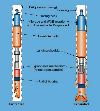What's happening in drilling
The Russians have arrivedRemember the old adage, the Russians are coming? Well, they have arrived, and with some very interesting technology. Despite significant improvements in sealed-bearing cone bits, retractable bits may serve a wide range of field applications. Some possible RB applications identified by Russian demonstrators were rapid retrieval of worn bits by reverse circulation or wireline, drilling with casing and under-reaming at high rates. Other possible applications were left to the imagination and could be identified on a questionnaire handed out by Mauer Engineering. Russian drilling technology. Retractable bits (RBs) were used to drill the world’s deepest well at Kola, Russia; and Maurer Engineering, as part of a DOE project on Russian drilling technology, is testing RBs. A demonstration was held at Maurer’s drilling research center, Houston, where Russian engineers asked where and how these bits could be used to solve drilling and completion problems.
Some representatives attending the demonstration included: Agip, Anadrill, ARCO, Chevron, Hughes Christensen, Hycalog, Hydril, Los Alamos National Lab, Marathon, Oil Tools Int’l., Reed Tool, Sandia National Labs, Signa, Texaco and Texas A&M. Russian engineers (Aquatic Co., Moscow) fielded questions and demonstrated bit functionality. An RB is both expandable and collapsible (expanded while drilling and collapsed for transport within the drill string). Transfer of cutting elements (cone set) from the collapsed (transport) position to the expanded (operational) position is carried out by means of a special, mostly hydraulically operated, expandable mechanism. Bit retrieval can be accomplished by either reverse circulation or wireline. Development of this tool provides methods of drilling without pulling drill pipe, resulting in: continuous wellbore cleaning during running or pulling tools (drilling, coring, milling, etc.) and reduced logging and drilling time. Some applications suggested for this technology were casing drilling and under-reaming at high rates. Applications of this technology depend on the need for other downhole drilling tools (many MWD/LWD tools are not retrievable). Casing-drilling technology update. Tesco has successfully completed two directional sidetracks on the previously announced test well using proprietary casing-drilling technology. For more detail on the original well, refer to World Oil’s "What’s happening in drilling," February 1999. The original well was plugged back from 3,040-ft TD and suspended with cement plugs into the 7-5/8-in. casing set at 577 ft. Cement was drilled out to 633 ft. A directional-drilling assembly, including a bent-housing mud motor, MWD tools and an isolation monel drill collar (deployed on wireline and latched in the bottom 5-1/2-in. casing joint) was run. The BHA was successfully retrieved and re-run on wireline several times without having to trip casing. Hole angle was built at 8°/100 ft to 85° at 1,775-ft MD (1,385-ft TVD). An additional 220 ft of hole was drilled to TD (1,995-ft MD). Difficulties were encountered while sliding (drilling ahead without casing rotation) due to the well’s shallow nature (low available string weight). Consequently, true 90° horizontal was not achieved (final angle was 84°). This situation can also be inherent to conventional drilling and is expected to be overcome with tool modifications and well design considerations. The lower open-hole interval was plugged back to 1,075-ft MD to enable a second directional interval to be drilled. An open-hole sidetrack was initiated at 1,010-ft MD with a 30° well deviation. After two attempts, the well was sidetracked and the second leg was drilled to a final 60.5° angle at 1,517-ft MD (1,369-ft TVD). The final wellbore was suspended with a cement plug to 968-ft MD. This suspended wellbore will be used for continued testing of technical drilling and completion services and products. Upon completion of drilling operations, the casing was recovered and inspected to determine any wear or damage. The lower 20 joints showed no damage, while two upper couplings exhibited some damage. Further evaluation and testing of this coupling type is planned so that full casing integrity can be maintained throughout drilling and production operations. To further evaluate casing drilling for directional and horizontal wells, Tesco is
planning and applying for approvals to drill another multi-lateral well at its R&D test
center. The well will enable testing of advanced tools and additional casing sizes.
Copyright © 1999 World
Oil |
- Applying ultra-deep LWD resistivity technology successfully in a SAGD operation (May 2019)
- Adoption of wireless intelligent completions advances (May 2019)
- Majors double down as takeaway crunch eases (April 2019)
- What’s new in well logging and formation evaluation (April 2019)
- Qualification of a 20,000-psi subsea BOP: A collaborative approach (February 2019)
- ConocoPhillips’ Greg Leveille sees rapid trajectory of technical advancement continuing (February 2019)




